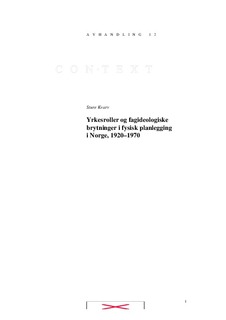| dc.description.abstract | The purpose of the Ph D. project is to conduct an investigation into the planner’s role in the field of socially motivated modernism in Norway and Sweden in the period 1920–1970. The influential figures among Norwegian planners had their background from the Socialist Architects´ Society and their journal Plan. Plan represented an alternative to the official housing policy and urban planning in the years before the outbreak of World War II. Editorial policies in Plan were important starting points in the establishing of the social-democratic housing policy and urban planning in the post-war period in Norway. The journal Byggmästaren has had a similar influence on the development of the urban planning and the planner’s role in Sweden. The dissertation offers new insights into the political and ideological development of urban planning in Norway and Sweden after 1945. Journals and political documents constitute my most significant sources. In the selection of normative texts from the journals, special weight has been given to the authors’ view of and influence on the role of the urban planner. In addition, the dissertation includes analyses of correspondence (from private archives and those of various associations), programme declarations and proposals for new city plans. The dissertation concludes that a paradigmatic approach to architecture and urban planning has obvious weaknesses, particularly with regard to empirical evidence from the Norwegian context. Such an approach will easily lead to an exaggerated emphasis on temporary ruptures and schisms, whereas elements representing continuity in urban planning (such as social hygienism), remain undervalued. Simultaneously, such an approach runs the risk of not paying sufficient attention to those aspects of the planner’s role that have changed little over time. Continuity, as a significant dimension of modern urban and social planning, became evident in the dual role of the public planner as, on the one hand, a social engineer with an optimistic view of modern development, and, on the other, a kind of social worker. In addition to the dual role, a third role can be identified, a kind of hygiene–care–role. | |
